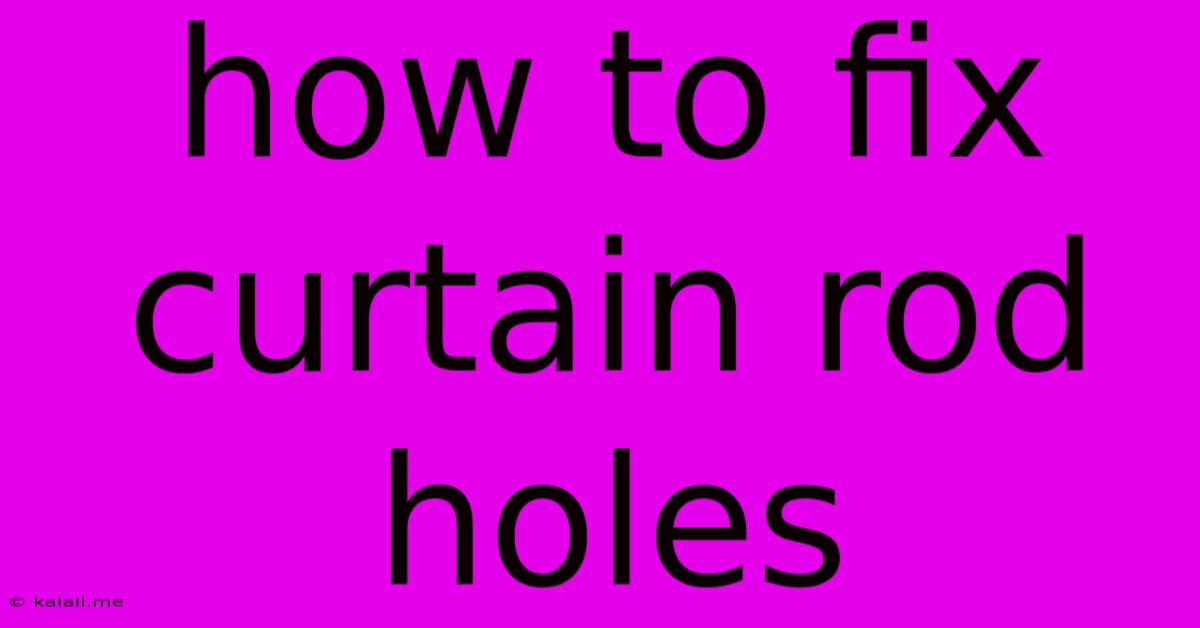How To Fix Curtain Rod Holes
Kalali
Jun 06, 2025 · 4 min read

Table of Contents
How to Fix Curtain Rod Holes: A Complete Guide
Meta Description: Learn how to repair unsightly curtain rod holes in your walls – from patching small holes to fixing larger damage, this guide offers simple, effective solutions for a flawless finish. We cover various techniques and materials for a professional look.
Curtain rods are a practical and stylish way to dress your windows, but removing them can often leave behind unsightly holes in your walls. Fortunately, fixing these holes is achievable with a few simple techniques and readily available materials. This guide will walk you through various methods, depending on the size and severity of the damage.
Assessing the Damage: The First Step to Repair
Before you begin, take a moment to assess the size and condition of the holes. This will determine the best approach for repair.
- Small Holes (less than ¼ inch): These are the easiest to fix and often require only spackle or patching compound.
- Medium Holes (¼ inch to ½ inch): These might need a slightly more involved approach, possibly using wood filler for added strength.
- Large Holes (larger than ½ inch): Larger holes may require more extensive repair, including potentially using drywall pieces to patch the damaged area.
Materials You’ll Need:
Regardless of hole size, you’ll likely need some or all of these materials:
- Spackle or Patching Compound: This is ideal for smaller holes.
- Wood Filler: Provides extra strength and is suitable for medium-sized holes.
- Drywall Compound (Mud): Necessary for larger holes or significant damage.
- Putty Knife: For applying and smoothing the patching compound or filler.
- Sandpaper: Essential for achieving a smooth, even surface. Start with coarser grit (like 100-grit) and finish with finer grit (like 220-grit).
- Primer: Prepares the wall for painting and ensures better adhesion of the paint.
- Paint: Matching your wall color is crucial for an invisible repair.
- Painter's Tape: To protect surrounding areas during painting.
- Drop Cloth or Old Newspaper: To protect your floor from paint spills.
- Small Brush or Sponge: For applying primer and paint to smaller areas.
- (Optional) Drywall Patch: For larger holes requiring more substantial repair.
Fixing Small Holes: The Quick and Easy Method
For small holes, spackle is your best friend. Simply follow these steps:
- Clean the Hole: Remove any loose debris or dust from the hole.
- Apply Spackle: Use a putty knife to apply a small amount of spackle, pressing it gently into the hole and slightly beyond the edges to create a smooth, level surface.
- Smooth the Surface: Use the putty knife to remove any excess spackle, creating a smooth transition with the surrounding wall.
- Let it Dry: Allow the spackle to dry completely according to the manufacturer's instructions.
- Sand: Once dry, lightly sand the area with fine-grit sandpaper until it's smooth and flush with the wall.
- Prime and Paint: Apply a coat of primer followed by your wall paint to match the surrounding area.
Repairing Medium to Large Holes: A More Involved Approach
Larger holes require a more robust approach:
- Clean the Hole: Thoroughly clean the hole and remove any loose debris.
- Apply Wood Filler (Medium Holes): For holes up to ½ inch, wood filler offers added strength. Apply and smooth it just like spackle.
- Use Drywall Compound (Large Holes): For larger holes, apply drywall compound in thin layers, allowing each layer to dry before applying the next. This ensures a strong and stable repair. For significantly damaged areas, a drywall patch may be necessary.
- Sand Smoothly: Once dry, sand the area thoroughly with varying grits of sandpaper until completely smooth.
- Prime and Paint: Apply a coat of primer, followed by your matching wall paint.
Preventing Future Damage: Tips and Tricks
- Use heavier-duty curtain rods: This can reduce stress on the wall.
- Use appropriate wall anchors: Using appropriate anchors for your wall type (drywall, plaster, etc.) will provide extra support for your curtain rod and minimize the risk of damage.
- Consider alternative hanging methods: Explore alternatives like tension rods, which don’t require drilling holes in your walls.
By following these steps, you can effectively repair curtain rod holes, restoring your walls to their original pristine condition. Remember, patience and attention to detail are key to achieving a professional-looking finish.
Latest Posts
Latest Posts
-
Best Sealer For Pressure Treated Wood
Jun 06, 2025
-
Kid Show With Boy With Blue Hair
Jun 06, 2025
-
Is Arduino A Microcontroller Or Microprocessor
Jun 06, 2025
-
What Does Passing Mean In Code
Jun 06, 2025
-
El Que Tedeja El Culo Roto
Jun 06, 2025
Related Post
Thank you for visiting our website which covers about How To Fix Curtain Rod Holes . We hope the information provided has been useful to you. Feel free to contact us if you have any questions or need further assistance. See you next time and don't miss to bookmark.